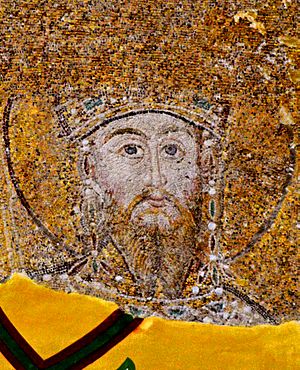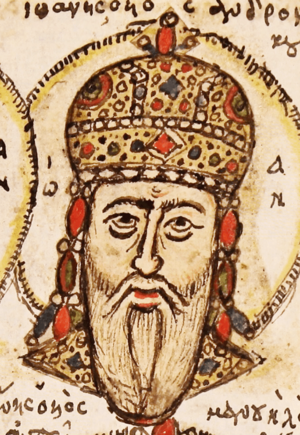John V Palaiologos facts for kids
Quick facts for kids John V Palaiologos |
|||||
|---|---|---|---|---|---|
| Emperor and Autocrat of the Romans | |||||

Restored mosaic of John V Palaiologos in the eastern arch of Hagia Sophia.
|
|||||
| Byzantine emperor | |||||
| 1st reign | 15 June 1341 – 12 August 1376 |
||||
| Coronation | 19 November 1341 | ||||
| Predecessor | Andronikos III Palaiologos | ||||
| Successor | Andronikos IV Palaiologos | ||||
| Co-emperor | John VI Kantakouzenos (1347–1354) | ||||
| 2nd reign | 1 July 1379 – 14 April 1390 | ||||
| Successor | John VII Palaiologos | ||||
| 3rd reign | 17 September 1390 – 16 February 1391 |
||||
| Successor | Manuel II Palaiologos | ||||
| Born | 18 June 1332 Didymoteicho, Byzantine Empire |
||||
| Died | 16 February 1391 (aged 58) Constantinople |
||||
| Spouse | Helena Kantakouzene | ||||
| Issue |
|
||||
|
|||||
| House | Palaiologos | ||||
| Father | Andronikos III Palaiologos | ||||
| Mother | Anna of Savoy | ||||
John V Palaiologos (Greek: Ἰωάννης Παλαιολόγος; born June 18, 1332 – died February 16, 1391) was a Byzantine emperor. He ruled from 1341 to 1391, though his time on the throne was interrupted several times.
John V was the son of Emperor Andronikos III Palaiologos and Anna of Savoy. His long reign was a very difficult time for the Byzantine Empire. It was filled with civil wars, a weakening of the emperor's power, and the growing strength of the Ottoman Turks. He became emperor when he was only eight years old.
Contents
Becoming Emperor and Early Challenges
John V became emperor at a very young age. Because he was so young, a "regency council" was set up to rule for him. A regent is someone who governs a country when the king or queen is too young or unable to rule.
This council included his mother, Anna, and other important leaders. However, his father's friend, John VI Kantakouzenos, also wanted to be the regent. This disagreement led to a civil war that lasted for several years. During this time, John V's mother even had to pawn the Byzantine crown jewels to get money.
Adding to the problems, the terrible disease known as the Black Death hit Constantinople between 1346 and 1349. This plague caused widespread death and made the empire even weaker.
Another Civil War and Ottoman Expansion
In 1347, John VI Kantakouzenos won the first civil war and became co-emperor with John V. But peace did not last long. In 1352, another civil war broke out. This time, it was between John V and John VI's son, Matthew Kantakouzenos.
John V asked for help from Stefan Dušan, the ruler of Serbia. Dušan sent 4,000 horsemen to help him. Matthew Kantakouzenos, in turn, got help from the Ottoman Turks. About 10,000 Ottoman soldiers arrived and fought against John V's Serbian allies. The Ottomans won this battle.
This victory was very important for the Ottoman Empire. It allowed them to gain their first territory in Europe, at Çimpe and Gallipoli. In 1354, John V was able to take back Constantinople. He removed John VI Kantakouzenos from power and later also removed Matthew.
Struggles and Seeking Help from the West
The Ottoman Turks continued to grow stronger and put pressure on John V. They took important cities like Adrianople and Philippopolis. John V was forced to pay them tribute, which is like a payment to a stronger power.
Desperate for help, John V traveled to Europe. In 1366, he visited King Louis I of Hungary. He hoped to get military support against the Ottomans. However, the Hungarian king would only help if John V agreed to join the Catholic Church and accept the Pope as the head of all churches. John V left Hungary without any help.
He continued his journey, even visiting Rome in 1369. There, he officially converted to Catholicism and recognized the Pope's authority. This was a big step, but it did not end the split between the Eastern Orthodox and Roman Catholic churches. It also did not bring the military help he needed. John V was the last Byzantine emperor to visit Rome.
Loss of Power and Final Years
John V's empire was very poor due to constant wars. When he visited Venice in 1369, he was even held because he owed money. In 1371, he had to accept that the Ottoman sultan Murad I was his overlord. This meant the Byzantine Empire was no longer fully independent.
Later, Murad I even helped John V against his own son, Andronikos IV Palaiologos, who had tried to take the throne in 1376.
In 1390, John V's grandson, John VII Palaiologos, briefly took the throne but was quickly overthrown. That same year, John V tried to make the Golden Gate in Constantinople stronger. He used marble from old, ruined churches for this. However, the new Ottoman sultan, Bayezid I, demanded that John V tear down these new defenses. Bayezid threatened war and even to blind John V's son, Manuel, who was held captive.
John V had to obey the Sultan's order. This humiliation deeply affected him. He died soon after, on February 16, 1391, and was buried in Constantinople. His son, Manuel II Palaiologos, became the next emperor. Another younger son, Theodore I Palaiologos, became the ruler of Despotate of Morea in 1383.
Family Life
John V married Helena Kantakouzene on May 28, 1347. Helena was the daughter of his co-emperor, John VI Kantakouzenos. They had at least eleven children together, including five sons and at least six daughters.
Their children included:
- Andronikos IV Palaiologos (born 1348)
- Irene Palaiologina (born around 1349)
- Manuel II Palaiologos (born 1350)
- Theodore I Palaiologos, Lord of Morea (born around 1355)
- Michael Palaiologos (died 1376/1377)
- Maria Palaiologina, who married the Ottoman sultan Murad I.
- Several other daughters.
See also
 In Spanish: Juan V Paleólogo para niños
In Spanish: Juan V Paleólogo para niños


